sensor ACURA NSX 1997 Service Service Manual
[x] Cancel search | Manufacturer: ACURA, Model Year: 1997, Model line: NSX, Model: ACURA NSX 1997Pages: 1503, PDF Size: 57.08 MB
Page 654 of 1503
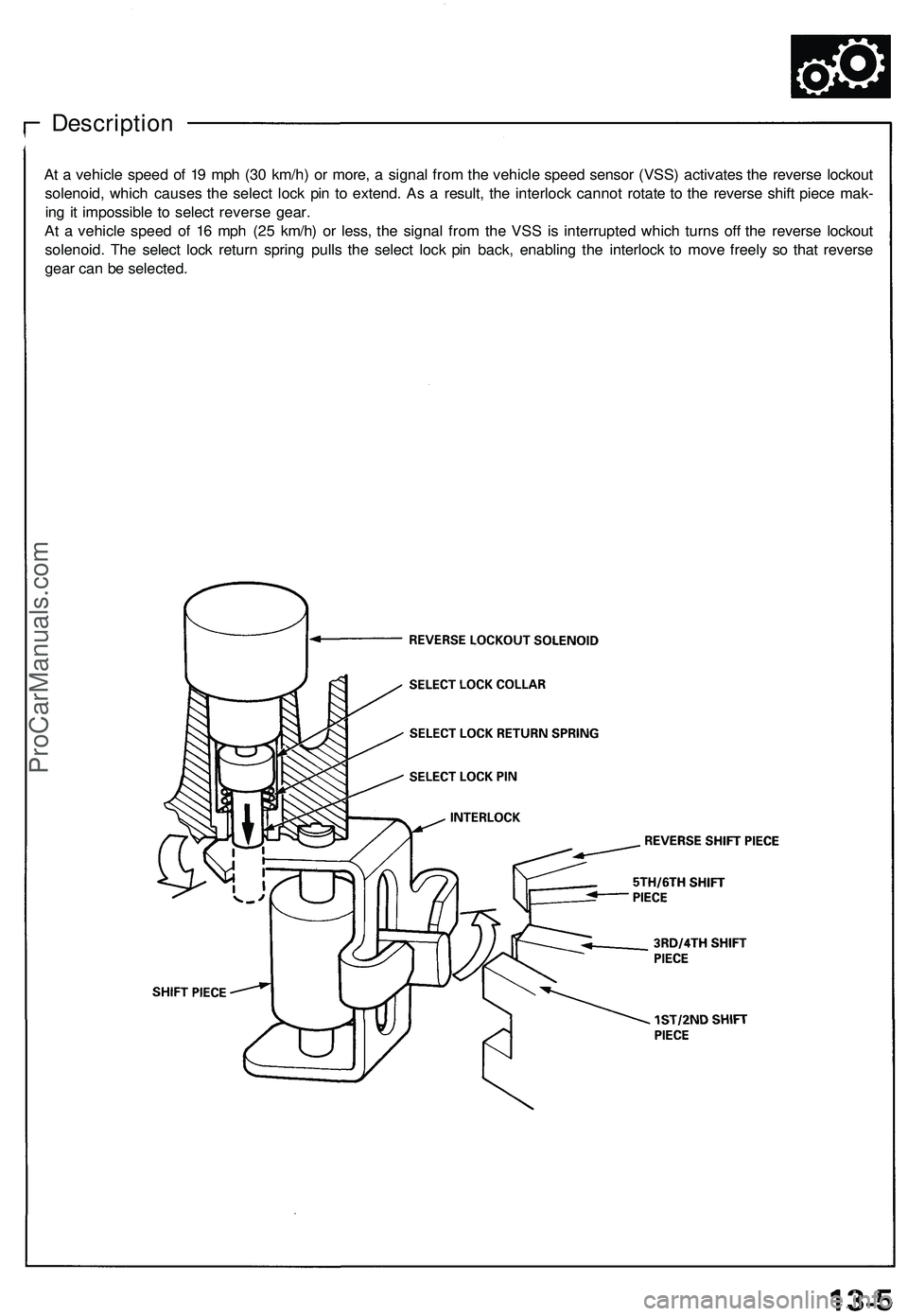
Description
At a vehicle speed of 19 mph (30 km/h) or more, a signal from the vehicle speed sensor (VSS) activates the reverse lockout
solenoid, which causes the select lock pin to extend. As a result, the interlock cannot rotate to the reverse shift piece mak-
ing it impossible to select reverse gear.
At a vehicle speed of 16 mph (25 km/h) or less, the signal from the VSS is interrupted which turns off the reverse lockout
solenoid. The select lock return spring pulls the select lock pin back, enabling the interlock to move freely so that reverse
gear can be selected.ProCarManuals.com
Page 660 of 1503
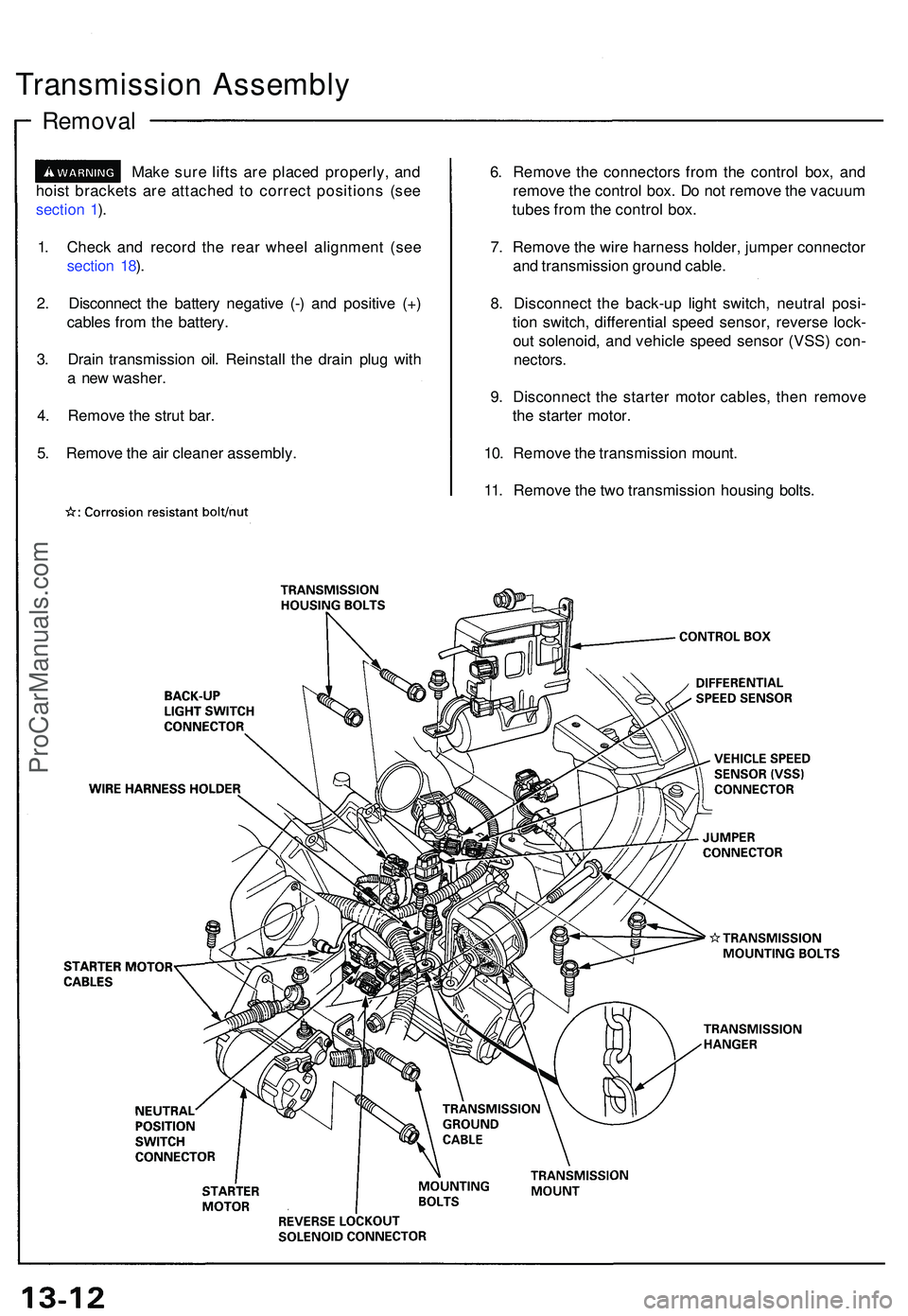
Transmission Assembl y
Removal
Make sur e lift s ar e place d properly , an d
hois t bracket s ar e attache d t o correc t position s (se e
sectio n 1 ).
1 . Chec k an d recor d th e rea r whee l alignmen t (se e
sectio n 18 ).
2 . Disconnec t th e batter y negativ e (- ) an d positiv e (+ )
cable s fro m th e battery .
3 . Drai n transmissio n oil . Reinstal l th e drai n plu g wit h
a ne w washer .
4 . Remov e th e stru t bar .
5 . Remov e th e ai r cleane r assembly . 6
. Remov e th e connector s fro m th e contro l box , an d
remov e th e contro l box . D o no t remov e th e vacuu m
tube s fro m th e contro l box .
7 . Remov e th e wir e harnes s holder , jumpe r connecto r
an d transmissio n groun d cable .
8 . Disconnec t th e back-u p ligh t switch , neutra l posi -
tio n switch , differentia l spee d sensor , revers e lock -
ou t solenoid , an d vehicl e spee d senso r (VSS ) con -
nectors .
9. Disconnec t th e starte r moto r cables , the n remov e
th e starte r motor .
10 . Remov e th e transmissio n mount .
11 . Remov e th e tw o transmissio n housin g bolts .
ProCarManuals.com
Page 706 of 1503
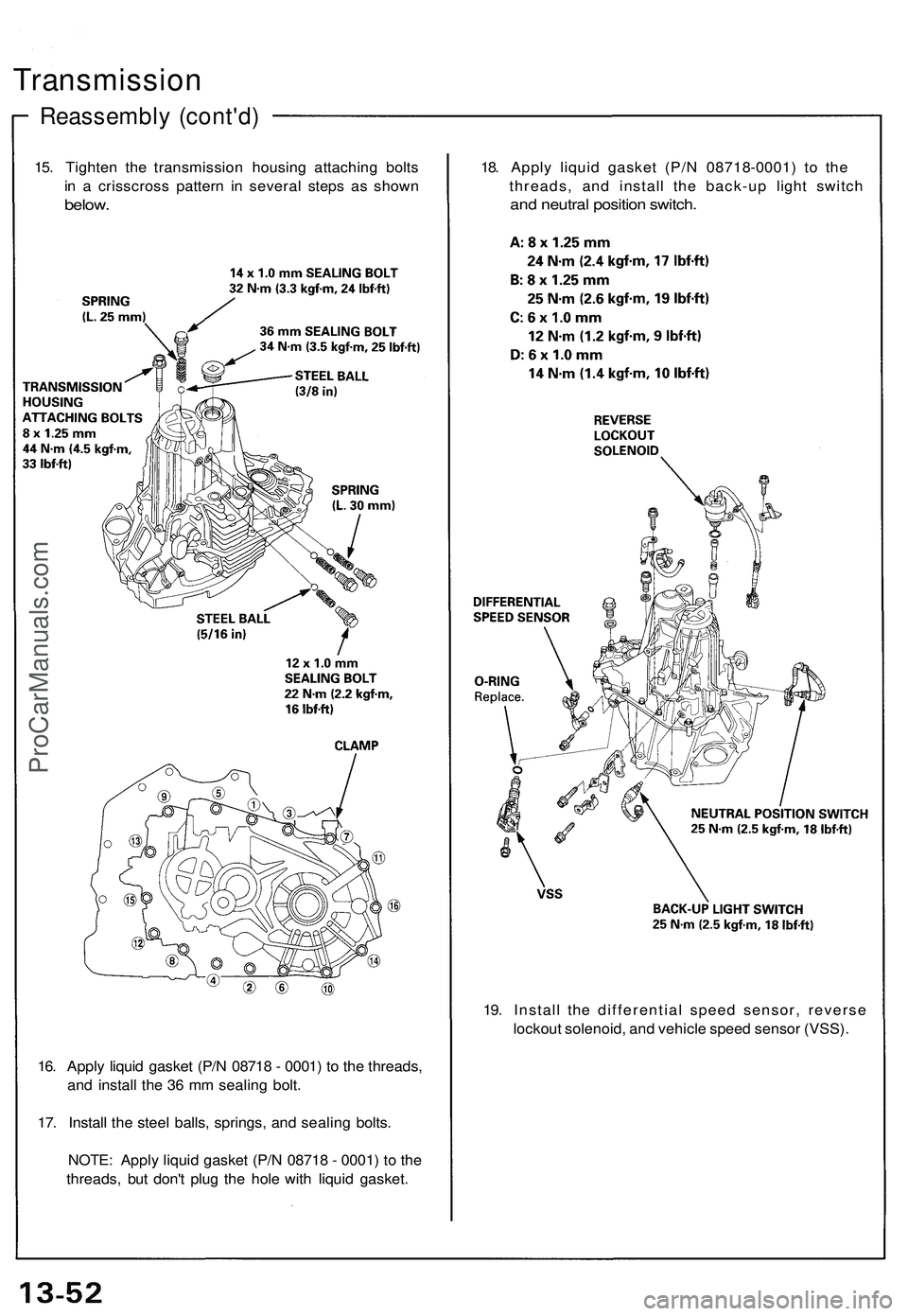
15. Tighte n th e transmissio n housin g attachin g bolt s
i n a crisscros s patter n i n severa l step s a s show n
below.
Transmissio n
Reassembly (cont'd )
18. Appl y liqui d gaske t (P/ N 0871 8-0001 ) t o th e
threads , an d instal l th e back-u p ligh t switc h
and neutra l positio n switch .
19. Instal l th e differentia l spee d sensor , revers e
lockou t solenoid , an d vehicl e spee d senso r (VSS) .
16 . Appl y liqui d gaske t (P/ N 0871 8 - 0001 ) t o th e threads ,
an d instal l th e 3 6 m m sealin g bolt .
17 . Instal l th e stee l balls , springs , an d sealin g bolts .
NOTE : Appl y liqui d gaske t (P/ N 0871 8 - 0001 ) t o th e
threads , bu t don' t plu g th e hol e wit h liqui d gasket .
ProCarManuals.com
Page 710 of 1503
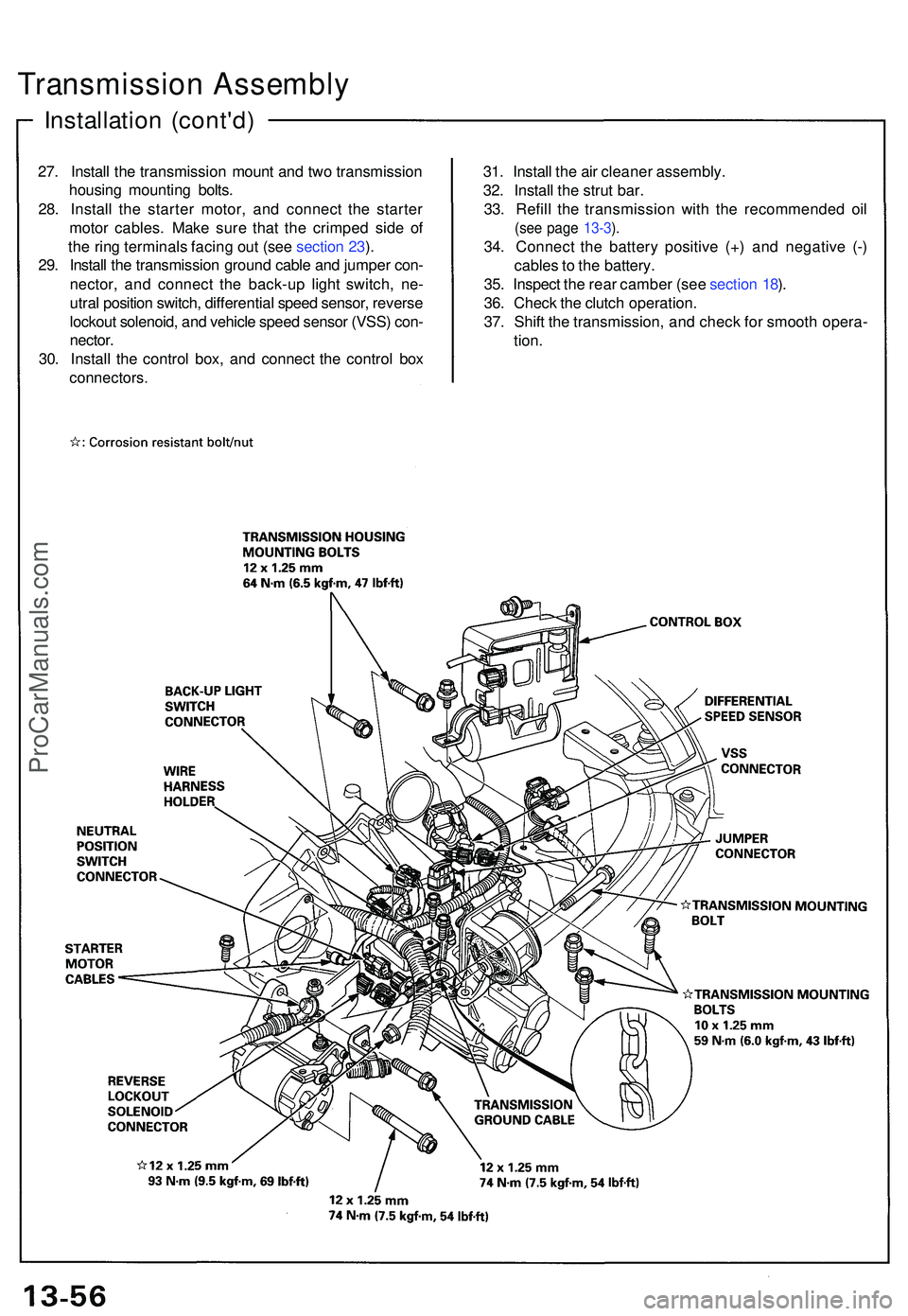
Transmission Assembl y
Installatio n (cont'd )
27. Instal l th e transmissio n moun t an d tw o transmissio n
housin g mountin g bolts .
28 . Instal l th e starte r motor , an d connec t th e starte r
moto r cables . Mak e sur e tha t th e crimpe d sid e o f
th e rin g terminal s facin g ou t (se e sectio n 23 ).
29 . Instal l th e transmissio n groun d cabl e an d jumpe r con -
nector , an d connec t th e back-u p ligh t switch , ne -
utra l positio n switch , differentia l spee d sensor , revers e
lockou t solenoid , an d vehicl e spee d senso r (VSS ) con -
nector .
30 . Instal l th e contro l box , an d connec t th e contro l bo x
connectors .
31. Instal l th e ai r cleane r assembly .
32 . Instal l th e stru t bar .
33 . Refil l th e transmissio n wit h th e recommende d oi l
(se e pag e 13-3 ).
34 . Connec t th e batter y positiv e (+ ) an d negativ e (- )
cable s to th e battery .
35 . Inspec t th e rea r cambe r (se e sectio n 18 ).
36 . Chec k th e clutc h operation .
37 . Shif t th e transmission, and chec k fo r smoot h opera -
tion .
ProCarManuals.com
Page 713 of 1503
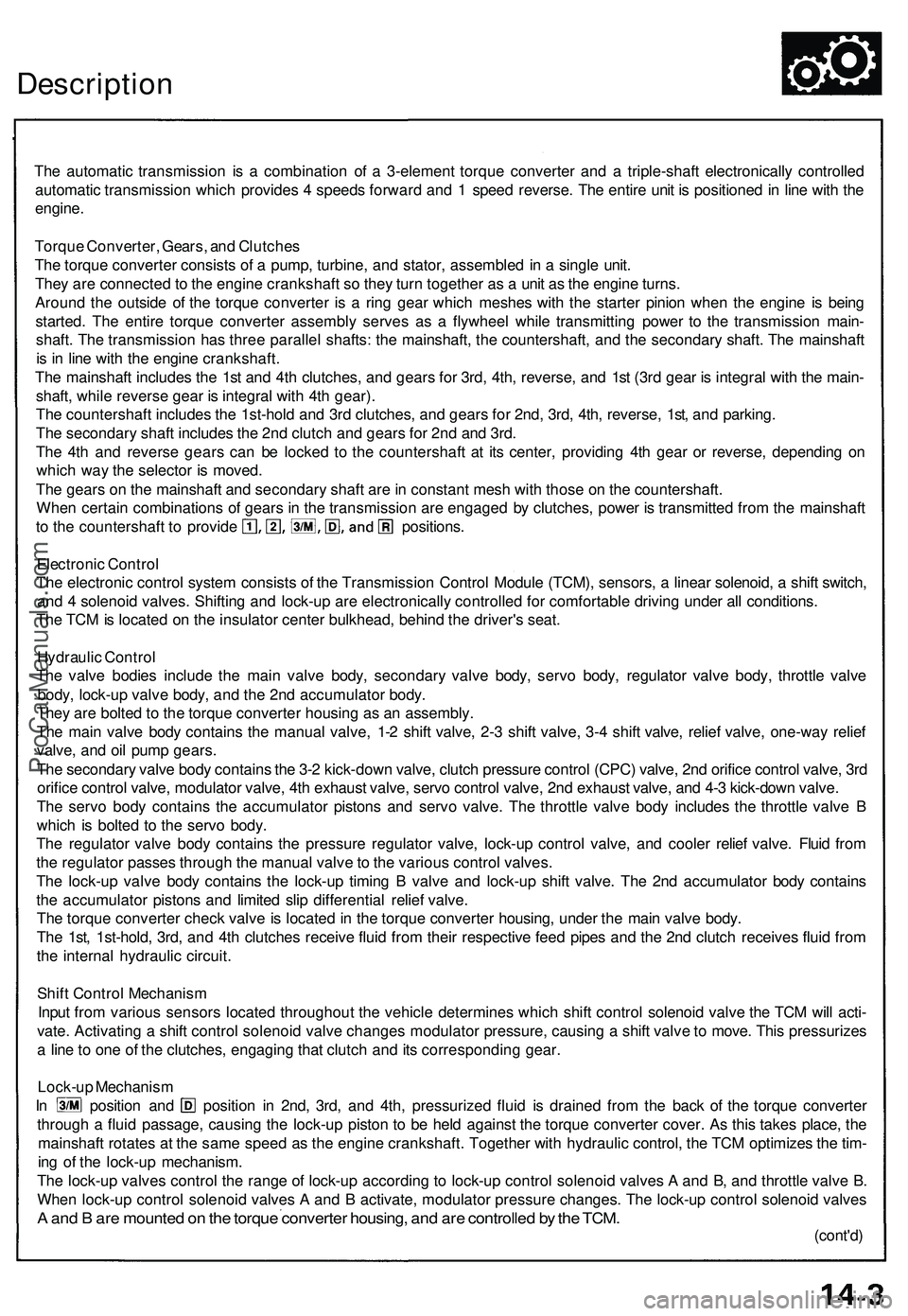
Description
The automatic transmission is a combination of a 3-element torque converter and a triple-shaft electronically controlled
automatic transmission which provides 4 speeds forward and 1 speed reverse. The entire unit is positioned in line with the
engine.
Torque Converter, Gears, and Clutches
The torque converter consists of a pump, turbine, and stator, assembled in a single unit.
They are connected to the engine crankshaft so they turn together as a unit as the engine turns.
Around the outside of the torque converter is a ring gear which meshes with the starter pinion when the engine is being
started. The entire torque converter assembly serves as a flywheel while transmitting power to the transmission main-
shaft. The transmission has three parallel shafts: the mainshaft, the countershaft, and the secondary shaft. The mainshaft
is in line with the engine crankshaft.
The mainshaft includes the 1st and 4th clutches, and gears for 3rd, 4th, reverse, and 1st (3rd gear is integral with the main-
shaft, while reverse gear is integral with 4th gear).
The countershaft includes the 1st-hold and 3rd clutches, and gears for 2nd, 3rd, 4th, reverse, 1st, and parking.
The secondary shaft includes the 2nd clutch and gears for 2nd and 3rd.
The 4th and reverse gears can be locked to the countershaft at its center, providing 4th gear or reverse, depending on
which way the selector is moved.
The gears on the mainshaft and secondary shaft are in constant mesh with those on the countershaft.
When certain combinations of gears in the transmission are engaged by clutches, power is transmitted from the mainshaft
to the countershaft to provide positions.
Electronic Control
The electronic control system consists of the Transmission Control Module (TCM), sensors, a linear solenoid, a shift switch,
and 4 solenoid valves. Shifting and lock-up are electronically controlled for comfortable driving under all conditions.
The TCM is located on the insulator center bulkhead, behind the driver's seat.
Hydraulic Control
The valve bodies include the main valve body, secondary valve body, servo body, regulator valve body, throttle valve
body, lock-up valve body, and the 2nd accumulator body.
They are bolted to the torque converter housing as an assembly.
The main valve body contains the manual valve, 1-2 shift valve, 2-3 shift valve, 3-4 shift valve, relief valve, one-way relief
valve, and oil pump gears.
The secondary valve body contains the 3-2 kick-down valve, clutch pressure control (CPC) valve, 2nd orifice control valve, 3rd
orifice control valve, modulator valve, 4th exhaust valve, servo control valve, 2nd exhaust valve, and 4-3 kick-down valve.
The servo body contains the accumulator pistons and servo valve. The throttle valve body includes the throttle valve B
which is bolted to the servo body.
The regulator valve body contains the pressure regulator valve, lock-up control valve, and cooler relief valve. Fluid from
the regulator passes through the manual valve to the various control valves.
The lock-up valve body contains the lock-up timing B valve and lock-up shift valve. The 2nd accumulator body contains
the accumulator pistons and limited slip differential relief valve.
The torque converter check valve is located in the torque converter housing, under the main valve body.
The 1st, 1st-hold, 3rd, and 4th clutches receive fluid from their respective feed pipes and the 2nd clutch receives fluid from
the internal hydraulic circuit.
Shift Control Mechanism
Input from various sensors located throughout the vehicle determines which shift control solenoid valve the TCM will acti-
vate. Activating a shift control solenoid valve changes modulator pressure, causing a shift valve to move. This pressurizes
a line to one of the clutches, engaging that clutch and its corresponding gear.
Lock-up Mechanism
In position and position in 2nd, 3rd, and 4th, pressurized fluid is drained from the back of the torque converter
through a fluid passage, causing the lock-up piston to be held against the torque converter cover. As this takes place, the
mainshaft rotates at the same speed as the engine crankshaft. Together with hydraulic control, the TCM optimizes the tim-
ing of the lock-up mechanism.
The lock-up valves control the range of lock-up according to lock-up control solenoid valves A and B, and throttle valve B.
When lock-up control solenoid valves A and B activate, modulator pressure changes. The lock-up control solenoid valves
A and B are mounted on the torque converter housing, and are controlled by the TCM.
(cont'd)ProCarManuals.com
Page 724 of 1503
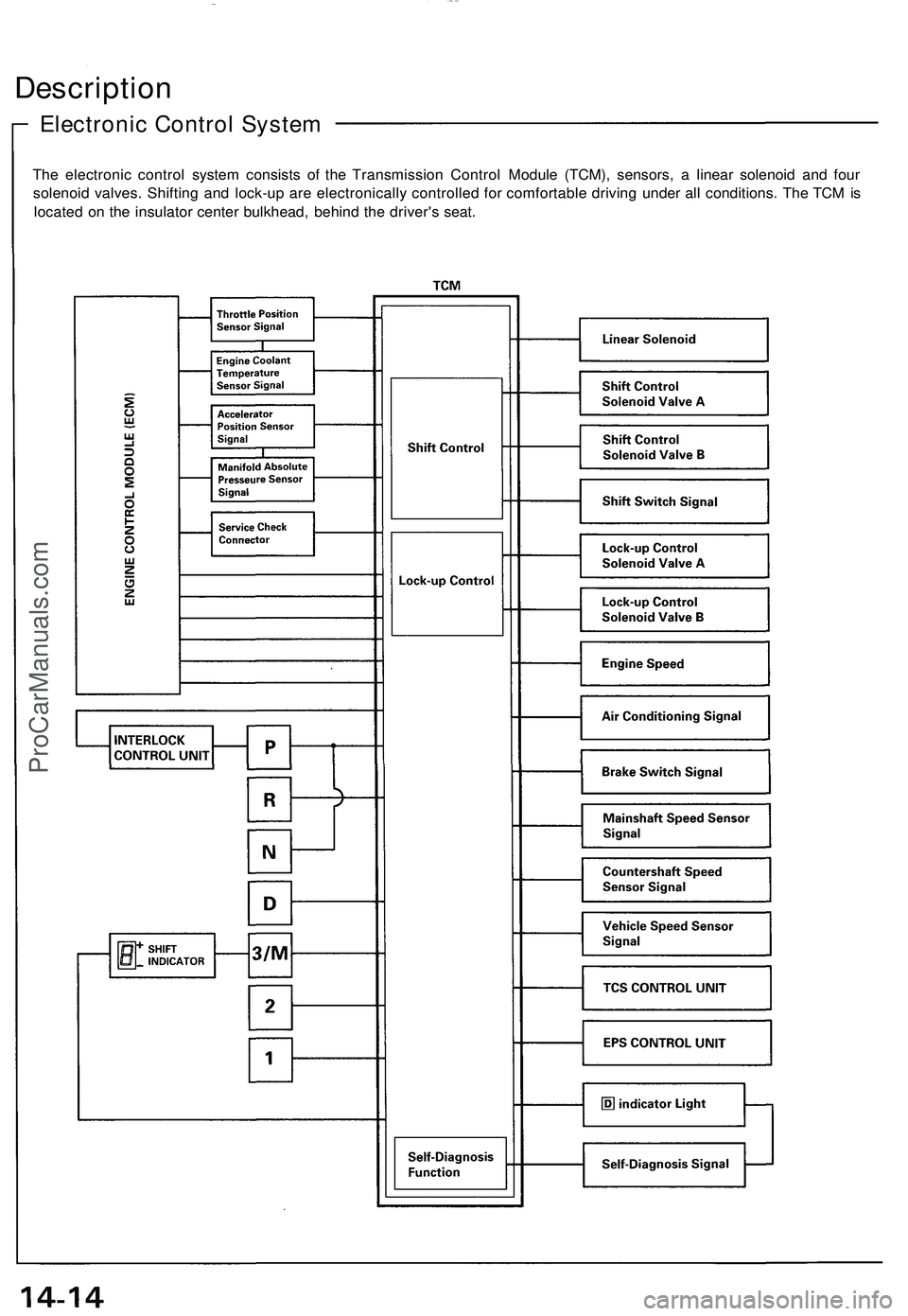
Description
Electronic Control System
The electronic control system consists of the Transmission Control Module (TCM), sensors, a linear solenoid and four
solenoid valves. Shifting and lock-up are electronically controlled for comfortable driving under all conditions. The TCM is
located on the insulator center bulkhead, behind the driver's seat.ProCarManuals.com
Page 725 of 1503
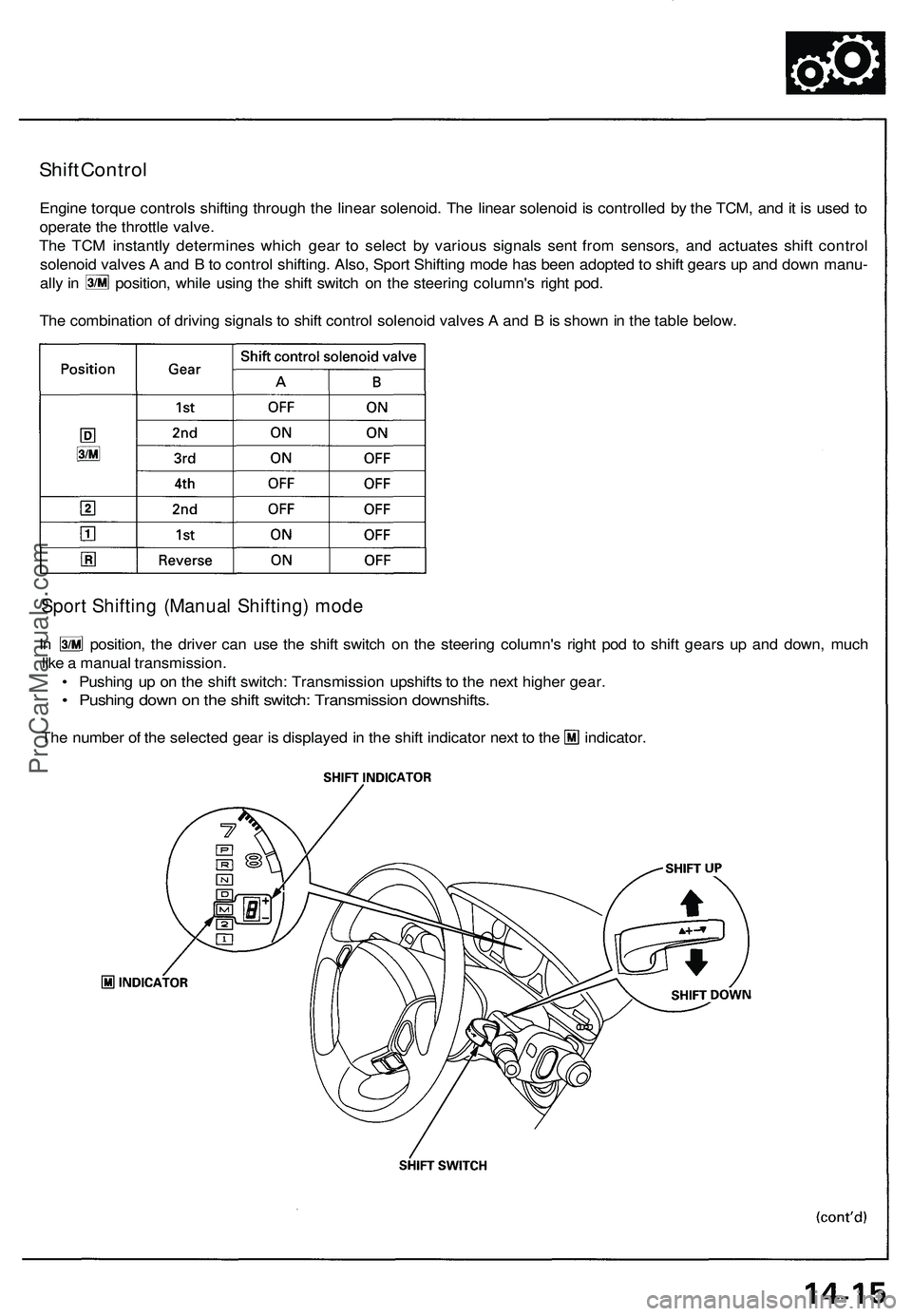
Shift Control
Engine torque controls shifting through the linear solenoid. The linear solenoid is controlled by the TCM, and it is used to
operate the throttle valve.
The TCM instantly determines which gear to select by various signals sent from sensors, and actuates shift control
solenoid valves A and B to control shifting. Also, Sport Shifting mode has been adopted to shift gears up and down manu-
ally in position, while using the shift switch on the steering column's right pod.
The combination of driving signals to shift control solenoid valves A and B is shown in the table below.
Sport Shifting (Manual Shifting) mode
In position, the driver can use the shift switch on the steering column's right pod to shift gears up and down, much
like a manual transmission.
• Pushing up on the shift switch: Transmission upshifts to the next higher gear.
• Pushing down on the shift switch: Transmission downshifts.
The number of the selected gear is displayed in the shift indicator next to the indicator.ProCarManuals.com
Page 726 of 1503
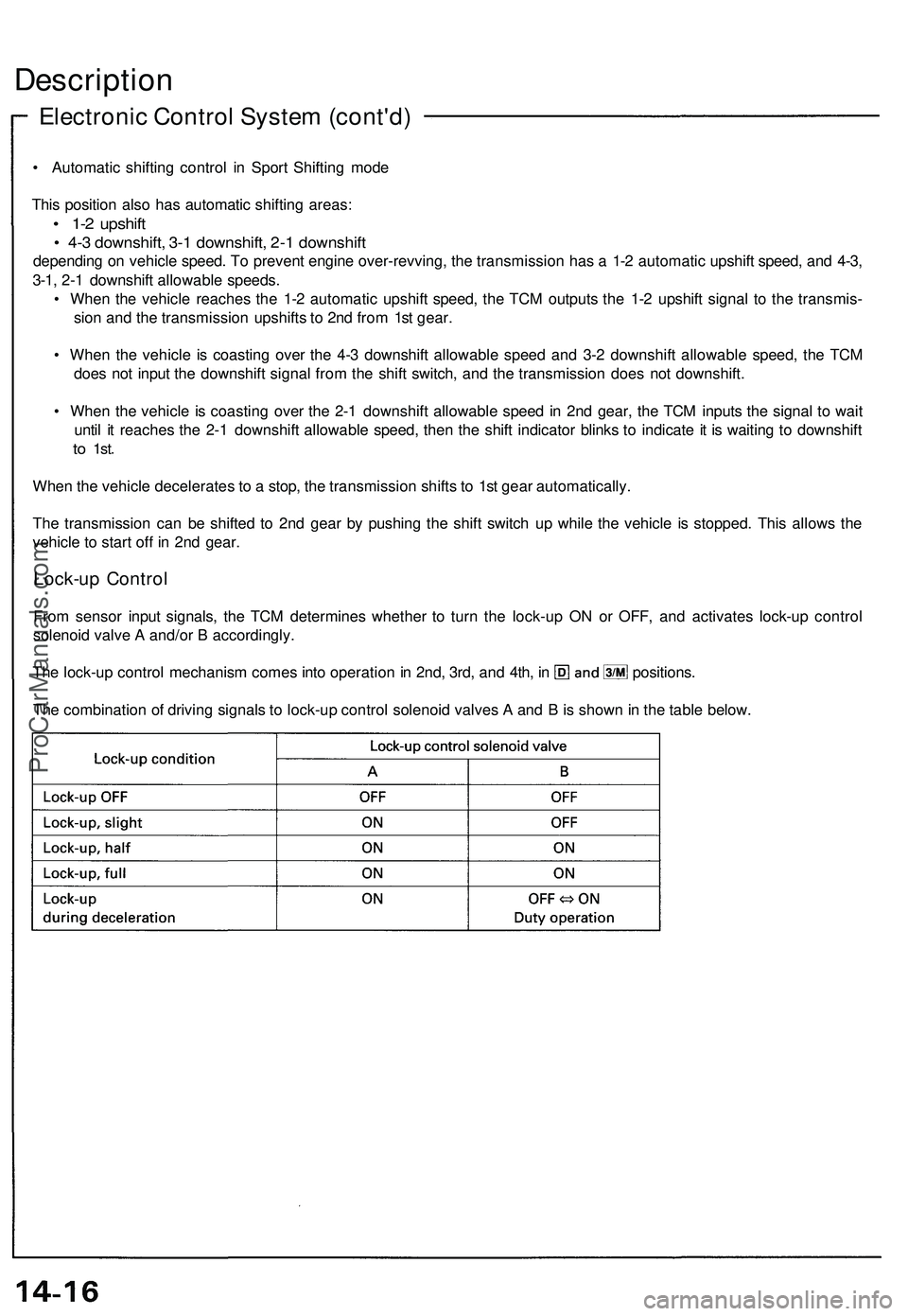
Electronic Control System (cont'd)
Description
• Automatic shifting control in Sport Shifting mode
This position also has automatic shifting areas:
• 1-2 upshift
• 4-3 downshift, 3-1 downshift, 2-1 downshift
depending on vehicle speed. To prevent engine over-revving, the transmission has a 1-2 automatic upshift speed, and 4-3,
3-1, 2-1 downshift allowable speeds.
• When the vehicle reaches the 1-2 automatic upshift speed, the TCM outputs the 1-2 upshift signal to the transmis-
sion and the transmission upshifts to 2nd from 1st gear.
• When the vehicle is coasting over the 4-3 downshift allowable speed and 3-2 downshift allowable speed, the TCM
does not input the downshift signal from the shift switch, and the transmission does not downshift.
• When the vehicle is coasting over the 2-1 downshift allowable speed in 2nd gear, the TCM inputs the signal to wait
until it reaches the 2-1 downshift allowable speed, then the shift indicator blinks to indicate it is waiting to downshift
to
1st.
When the vehicle decelerates to a stop, the transmission shifts to 1st gear automatically.
The transmission can be shifted to 2nd gear by pushing the shift switch up while the vehicle is stopped. This allows the
vehicle to start off in 2nd gear.
Lock-up Control
From sensor input signals, the TCM determines whether to turn the lock-up ON or OFF, and activates lock-up control
solenoid valve A and/or B accordingly.
The lock-up control mechanism comes into operation in 2nd, 3rd, and 4th, in positions.
The combination of driving signals to lock-up control solenoid valves A and B is shown in the table below.ProCarManuals.com
Page 756 of 1503
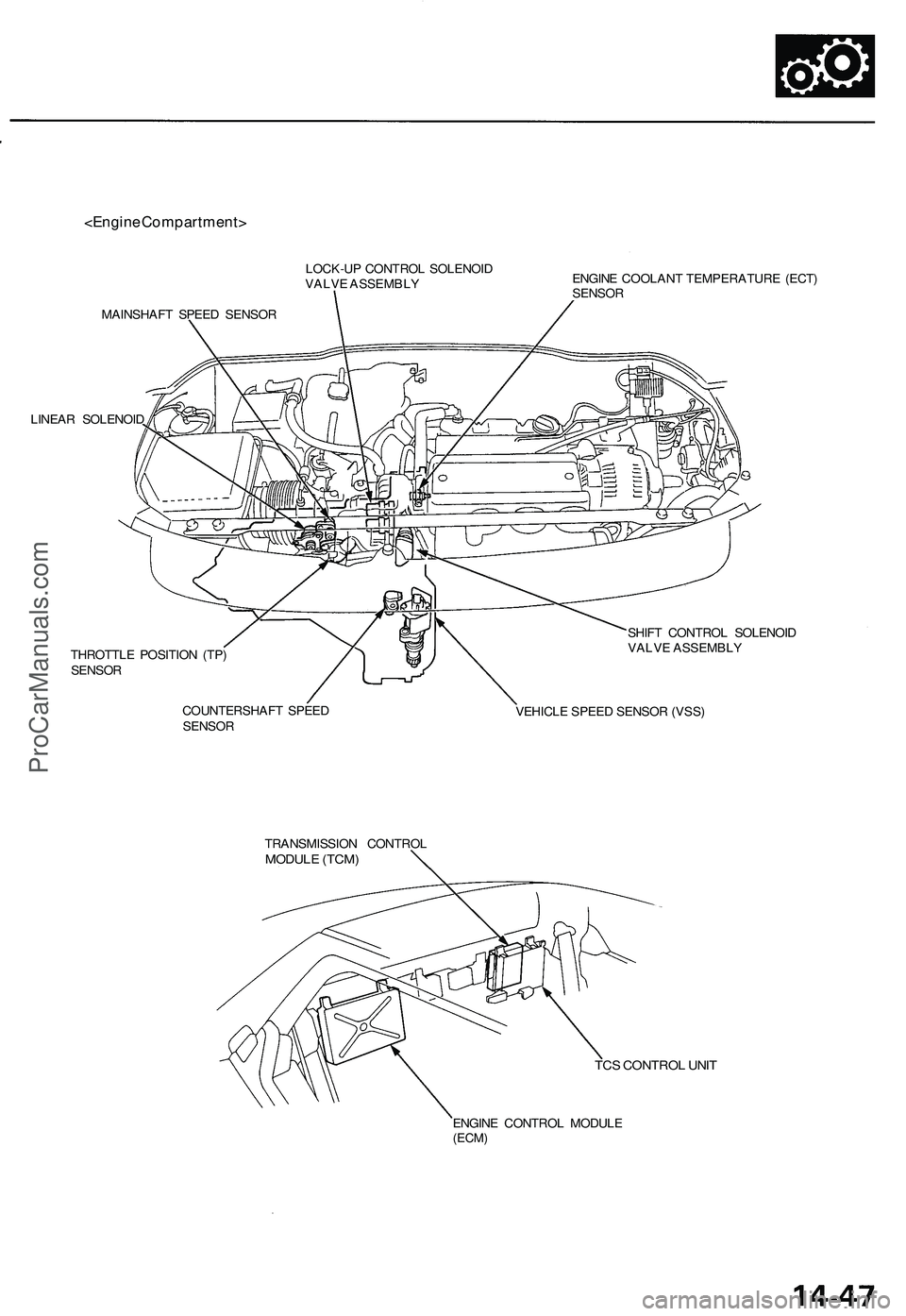
LOCK-UP CONTROL SOLENOID
VALVE ASSEMBLY
MAINSHAFT SPEED SENSOR
LINEAR SOLENOID
ENGINE COOLANT TEMPERATURE (ECT)
SENSOR
THROTTLE POSITION (TP)
SENSOR
COUNTERSHAFT SPEED
SENSOR
SHIFT CONTROL SOLENOID
VALVE ASSEMBLY
VEHICLE SPEED SENSOR (VSS)
TRANSMISSION CONTROL
MODULE (TCM)
TCS CONTROL UNIT
ENGINE CONTROL MODULE
(ECM)ProCarManuals.com
Page 764 of 1503
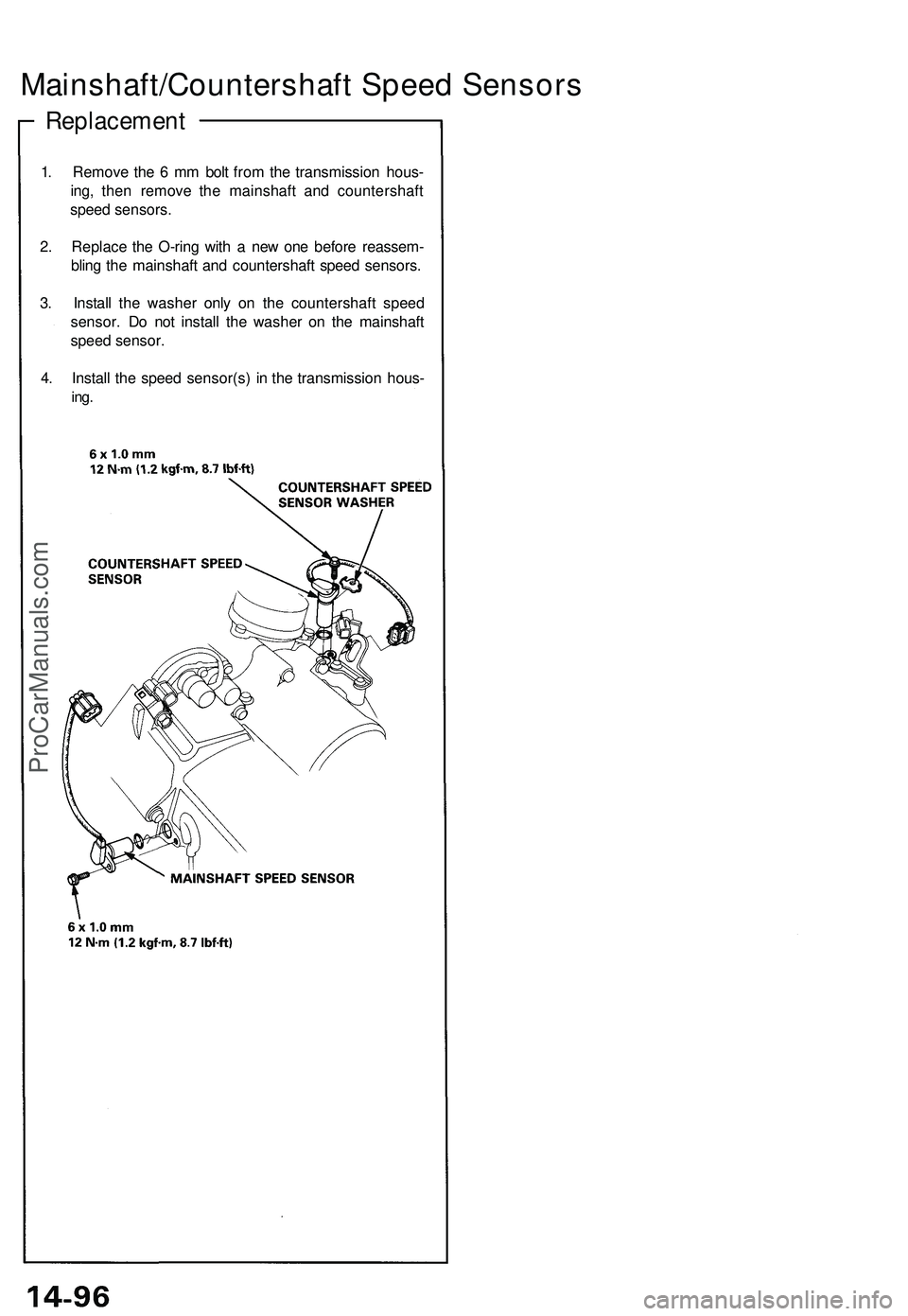
Mainshaft/Countershaft Speed Sensors
Replacement
1. Remov e th e 6 m m bol t fro m th e transmissio n hous -
ing , the n remov e th e mainshaf t an d countershaf t
spee d sensors .
2 . Replac e th e O-rin g wit h a ne w on e befor e reassem -
blin g th e mainshaf t an d countershaf t spee d sensors .
3 . Instal l th e washe r onl y o n th e countershaf t spee d
sensor . D o no t instal l th e washe r o n th e mainshaf t
spee d sensor .
4 . Instal l th e spee d sensor(s ) i n th e transmissio n hous -
ing.
ProCarManuals.com